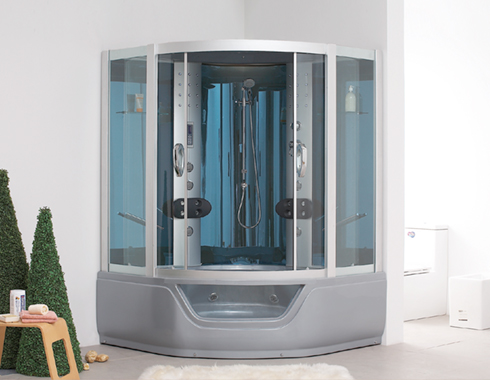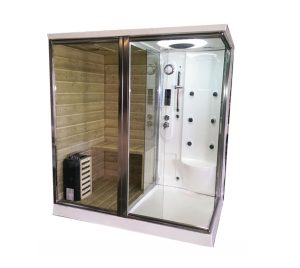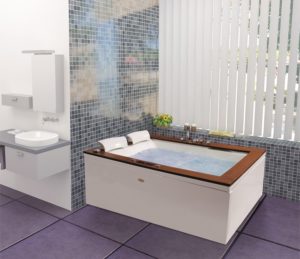More and more people are setting up wellness spaces at home these days. It’s a great way to take care of yourself without having to leave the house. Two popular options are steam cabins and saunas. But which one should you choose? This post will help you figure out the differences between steam cabins and saunas. By the end, you’ll have a better idea of which one fits your wellness needs best.
What is a Steam Cabin?
A steam cabin is a small, enclosed room that’s filled with warm, moist air. It’s like having your own personal spa right at home. Steam cabins work by heating water to create steam, which then fills the room. The steam makes the air very humid and warm, usually around 100-120°F (38-49°C).
You can get different types of steam cabins. Some come pre-made and just need to be installed. Others are built custom to fit your space. Most steam cabins have a few basic things in common. They’re usually made of materials that can handle lots of moisture. Many have a bench to sit on, and some even have built-in lights or music players.
Using a steam cabin is pretty simple. You turn it on, wait for it to heat up, and then step inside. The warm, moist air surrounds you, helping you relax and sweat. It’s a bit like being in a warm, foggy room. Many people find it very soothing.
Steam cabins can be a great addition to your home. They don’t usually take up too much space, and they can be a nice way to unwind after a long day. Plus, they’re not just for relaxing. Many people use them for health reasons too. The warm, moist air can be good for your skin and might help with breathing issues.
One thing to keep in mind is that steam cabins need regular cleaning. All that moisture can lead to mold if you’re not careful. But with a bit of upkeep, a steam cabin can be a wonderful addition to your wellness routine.
What is a Sauna?
A sauna is another type of small room used for relaxation and health. Unlike steam cabins, saunas use dry heat. The air in a sauna is hot but not humid. Temperatures in a sauna can range from 150-195°F (65-90°C), which is much hotter than a steam cabin.
Saunas have been around for a long time, especially in places like Finland where they’re a big part of the culture. There are a few different types of saunas. Traditional Finnish saunas use wood-burning stoves to heat the room. Electric saunas are more common in homes because they’re easier to use. There are also infrared saunas, which use a different kind of heat.
Most saunas are made of wood. Cedar is a popular choice because it smells nice and can handle the heat well. Saunas usually have benches at different levels. The higher you sit, the hotter it is. Many saunas also have rocks that you can pour water on to create a bit of steam. This gives a quick burst of heat and humidity.
Using a sauna is pretty straightforward. You sit in the hot room for a while, usually about 15-20 minutes at a time. Many people like to take short breaks to cool off and then go back in. Some folks even like to follow their sauna session with a cold shower or a dip in cool water.
Saunas can be a great way to relax and unwind. The heat can help soothe sore muscles and some people find it helps them sleep better. Like steam cabins, saunas are said to have health benefits. Some people use them to help with stress or to improve circulation.
One thing to remember about saunas is that they can be intense. The high heat isn’t for everyone, and it’s important to stay hydrated. But for many people, a sauna session is a great way to feel refreshed and relaxed.
Key Differences Between Steam Cabins and Saunas
Now that we’ve looked at what steam cabins and saunas are, let’s talk about how they’re different. The main things that set them apart are temperature, humidity, how they make heat, what they’re made of, and how much space they need.
Let’s start with temperature. Steam cabins are warm, but not super hot. They usually stay around 100-120°F (38-49°C). That’s about as warm as a hot summer day. Saunas, on the other hand, are much hotter. They can get up to 150-195°F (65-90°C). That’s so hot that you can’t touch the walls!
Humidity is another big difference. Steam cabins are very humid. The air is full of tiny water droplets, which is what makes it feel steamy. It’s like being in a really warm, foggy room. Saunas are the opposite. They have very dry air. Some people like to add a little humidity by pouring water on hot rocks, but it’s still much drier than a steam cabin.
The way they make heat is different too. Steam cabins use steam generators. These heat up water to make steam, which then fills the room. Saunas can use a few different things to make heat. Some use wood stoves, some use electric heaters, and some use infrared heaters. Each type gives a slightly different feel.
The materials used to build them are different as well. Steam cabins need to be made of stuff that can handle lots of moisture. They often use tile, glass, or special plastics. Saunas are usually made of wood. Cedar is popular because it smells nice and can take the heat.
Lastly, they need different amounts of space. Steam cabins can be pretty small. Some are not much bigger than a shower stall. Saunas are usually a bit bigger. They need room for benches at different heights and space for the heater.
These differences mean that steam cabins and saunas feel very different when you use them. A steam cabin feels warm and damp, while a sauna feels hot and dry. Which one you prefer often comes down to personal taste.
Health Benefits
Both steam cabins and saunas can be good for your health, but in slightly different ways. Let’s look at some of the benefits people talk about for each one.
Steam cabins are often said to be good for your breathing. The warm, moist air can help open up your airways. This might be helpful if you have a cold or allergies. Some people find it soothing for their throat and sinuses. The steam can also be good for your skin. It can help open up your pores and make your skin feel soft and clean.
Steam cabins might also help your muscles relax. The warm, moist air can help ease tension and soreness. Some people use them after working out to help their muscles recover. The humidity in a steam cabin can also make you sweat a lot. Some folks believe this helps get rid of toxins in your body, although scientists aren’t sure about this.
Saunas have their own set of potential benefits. Some studies suggest they might be good for your heart. The heat makes your heart beat faster, kind of like when you exercise. This might help improve your circulation. Saunas are also known for helping people relax and reduce stress. The quiet, warm environment can be very calming.
Like steam cabins, saunas can also help with sore muscles. The dry heat can penetrate deep into your muscles, which might help ease pain and stiffness. Some people find that using a sauna regularly helps them sleep better at night.
Both steam cabins and saunas make you sweat a lot. This can be refreshing and might help clean out your pores. Some people feel like it gives their skin a healthy glow. The heat from both can also help you relax and unwind after a long day.
It’s worth noting that while many people find these benefits helpful, everyone’s body is different. What works great for one person might not work as well for another. It’s always a good idea to check with your doctor before starting any new wellness routine, especially if you have any health conditions.
Choosing Between a Steam Cabin and Sauna
Picking between a steam cabin and a sauna comes down to what you like and what works best for your home. Here are some things to think about when making your choice.
First, think about your health and what you enjoy. If you like humidity and find it helps you breathe better, a steam cabin might be your best bet. If you prefer dry heat and want something that might help your muscles, a sauna could be the way to go.
Next, look at the space you have. Steam cabins can be pretty small, so they might fit better in a tight space. Saunas usually need a bit more room. Think about where you’d put it in your home and measure the space carefully.
Money is another big factor. Steam cabins and saunas can both be pricey, but the costs can vary. Steam cabins often need special plumbing and ventilation, which can add to the cost. Saunas might be simpler to install, but they can use more energy to run. Think about both the upfront cost and how much it’ll cost to use over time.
Also, consider how much work you’re willing to do to keep it clean and running well. Steam cabins need regular cleaning to prevent mold. Saunas need less frequent cleaning, but the wood might need oiling now and then to keep it in good shape.
Think about how it’ll look in your home too. Steam cabins often have a modern, spa-like look. Saunas usually have a more natural, wooden appearance. Pick the one that fits best with your home’s style.
Lastly, think about how often you’ll use it and why. If you want something for quick, daily use, a steam cabin might be better. If you prefer longer, more intense sessions a few times a week, a sauna could be a better fit.
Remember, there’s no one-size-fits-all answer. The best choice is the one that fits your lifestyle, your space, and your wellness goals.
Using Your New Wellness Space
Once you’ve picked either a steam cabin or a sauna, you’ll want to know how to use it well. Here are some tips to help you get the most out of your new wellness space.
First, think about how often you’ll use it. Most people find that a few times a week is a good balance. It’s enough to feel the benefits, but not so much that it takes over your life. Start slow and see what works for you.
How long you stay in is important too. In a steam cabin, 10-15 minutes is usually enough. The high humidity can be intense, so it’s best to keep sessions short. For saunas, you might stay in for 15-20 minutes at a time. Some people like to take breaks to cool off and then go back in.
Safety is key when using either one. Always stay hydrated. Drink water before, during, and after your session. If you start to feel dizzy or uncomfortable, it’s time to get out. Listen to your body and don’t push yourself too hard.
Keeping things clean is important too. For steam cabins, wipe down the surfaces after each use to prevent mold. For saunas, let it dry out completely after use and give it a good clean every so often.
You might want to add other things to your wellness routine too. Some people like to do some light stretching after a steam or sauna session. Others enjoy a cool shower or a cold drink. Find what feels good for you.
Remember, the goal is to relax and feel good. Don’t stress about doing it “right.” Use your steam cabin or sauna in a way that helps you unwind and feel your best.
Wrapping Up
Whether you choose a steam cabin or a sauna, you’re adding something special to your home. Both can be great for relaxation and might even have some health perks. The best choice depends on what you like, what your home can handle, and what fits your wellness goals.
Steam cabins offer a warm, humid environment that can be great for your skin and breathing. Saunas provide intense, dry heat that might help with muscle soreness and stress. Both can be wonderful ways to unwind after a long day.
Remember, it’s not just about picking one or the other. It’s about finding what helps you feel your best. Take your time, do your research, and pick the option that feels right for you.
We’d love to hear about your experiences with steam cabins or saunas. Have you tried either one? What did you think? Share your thoughts in the comments below. And if you’re still not sure which is right for you, consider talking to a wellness pro or a home renovation expert. They can give you advice based on your specific situation.




